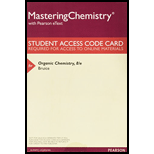
(a)
Interpretation:
The structures of products obtained from the reaction of
Concept Introduction:
The
An
(b)
Interpretation:
The optically activity of products obtained from the reaction of
Concept Introduction:
The
An E2 reaction is a concerted, one-step reaction in which the proton and the halide ion are removed in the same step.
(c)
Interpretation:
How would be the products differ if the starting material were the Trans isomer should be explained and the optical activity of products obtained from the Trans isomer should be explained.
Concept Introduction:
The
An
(d)
Interpretation:
The rate of formation of substitution products should be comparatively explained, where the cis and Trans isomers of 1-chloro-2-isopropylcyclopentan of with sodium methoxide in methanol.
Concept Introduction:
The
An E2 reaction is a concerted, one-step reaction in which the proton and the halide ion are removed in the same step.
(e)
Interpretation:
The rate of formation of elimination products should be comparatively explained, where the cis and Trans isomers of 1-chloro-2-isopropylcyclopentan of with sodium methoxide in methanol.
Concept Introduction:
The
An E2 reaction is a concerted, one-step reaction in which the proton and the halide ion are removed in the same step.
Want to see the full answer?
Check out a sample textbook solution
Chapter 9 Solutions
Organic Chemistry - MasteringChemistry
- (a) Draw all stereoisomers formed by monochlorination of the cis and trans isomers of 1,2-dimethylcyclobutane drawn below. (b) How many constitutional isomers are formed in each reaction? (c) Label any pairs of enantiomers formed.arrow_forwarda. How many stereoisomers are formed from the reaction of cyclohexene with NBS?b. How many stereoisomers are formed from the reaction of 3-methylcyclohexene with NBS?arrow_forward(a) Why does p-dichlorobenzene have a higher m.p. than its o- and m-isomers?(b) Why is (±)-Butan-2-ol optically inactive?arrow_forward
- a.What product(s) (excluding stereoisomers) are formed when Y is heated with Cl2? b.What product(s) (excluding stereoisomers) are formed when Y is heated with Br2? c.What steps are needed to convert Y to the alkene Z?arrow_forward4-Chloro-2-pentene has a double bond that can have either the E or the Z configuration and a stereogenic center that can have either the R or the S configuration. How many stereoisomers arepossible altogether? Draw the structure of each, and group the pairs of enantiomers.arrow_forwardDehydration of 1,2,2-trimethylcyclohexanol with H2SO4 affords 1-tertbutylcyclopentene as a minor product. (a) Draw a stepwise mechanism that shows how this alkene is formed. (b) Draw other alkenes formed in this dehydration. At least one must contain a five-membered ring.arrow_forward
- (a) What product(s) are formed when the E isomer of C6H5CH = CHC6H5 is treated with Br2, followed by one equivalent of KOH? Label the resulting alkene(s) as E or Z. (b) What product(s) are formed when the Z isomer of C6H5CH = CHC6H5 is subjected to the same reaction sequence? (c) How are the compounds in parts (a) and (b) related to each other?arrow_forwardThe stereochemistry of the products of reduction depends on the reagent used, as you learned in Sections 20.5 and 20.6. With this in mind, how would you convert 3,3-dimethylbutan-2-one [CH3COC(CH3)3] to: (a) racemic 3,3-dimethylbutan-2- ol [CH3CH(OH)C(CH3)3]; (b) only (R)-3,3-dimethylbutan-2-ol; (c) only (S)-3,3-dimethylbutan-2-ol?arrow_forward(a) Show how you would synthesize the pure (R) enantiomer of 2-butyl methyl sulfide, starting with pure (R)-butan-2-oland any reagents you need.(b) Show how you would synthesize the pure (S) enantiomer of the product, still starting with (R)-butan-2-ol and anyreagents you need.arrow_forward
- What are the intermediates J, K and L? What regiochemistry and stereochemistry is involved in each step? Why is M the only stereoisomer formed?arrow_forwardDraw all the possible products of the monochlorination of methylcyclopentane. Which ones are enantiomers?arrow_forwardRank the following alkenes from least to most stable. Then explain why you picked this order.arrow_forward
 Organic Chemistry: A Guided InquiryChemistryISBN:9780618974122Author:Andrei StraumanisPublisher:Cengage Learning
Organic Chemistry: A Guided InquiryChemistryISBN:9780618974122Author:Andrei StraumanisPublisher:Cengage Learning

